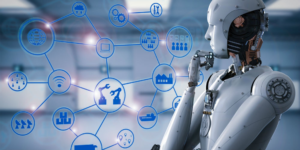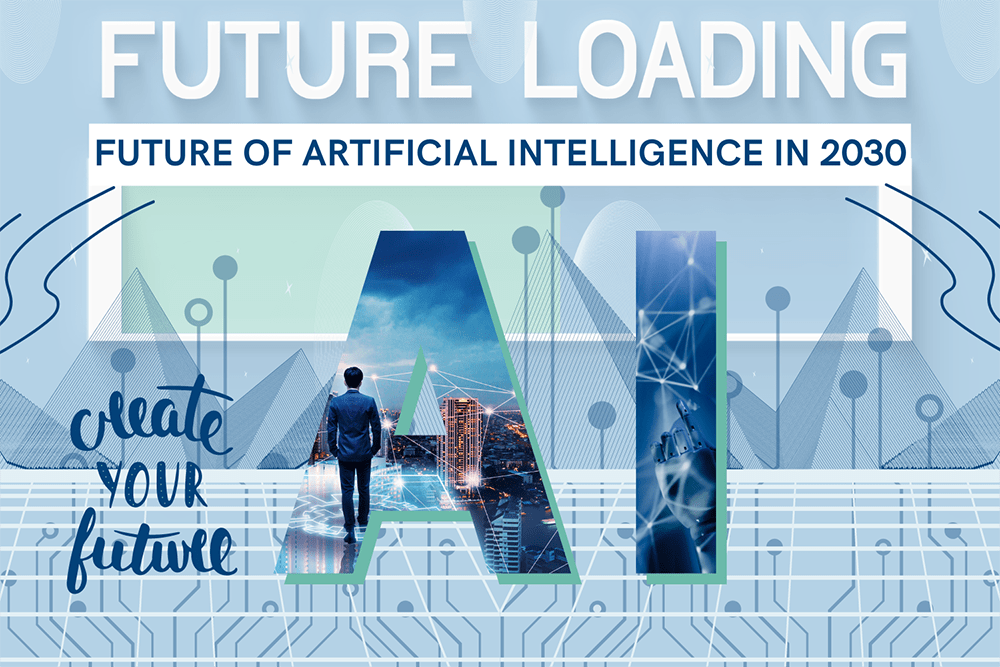Artificial intelligence will have a greater influence on our daily lives by 2030, and it might contribute up to $15.7 trillion to the global economy by that time. There are 10 significant artificial intelligence trends that will most likely exist in 2030.
In this article, what is the Future of Artificial Intelligence in 2030 is discussed.

1. AI Language Models Will Achieve Human Intelligence
According to futurist and engineer Ray Kurzweil, artificial intelligence will achieve human-level capability by 2030. This will be decided when AI is capable of passing a legitimate Turing test.
2. Collaboration between AI and humans will skyrocket across all professions:
By 2030, artificial intelligence (AI) will be an essential component of day-to-day company operations, assisting individuals in their creative activities, producing new ideas, and solving previously unachievable technologies. In some cases, collaborating with AI will be needed.
There are already good AI technologies used in creative professions, for example:
- VizCom generates rendered copies of sketches you supply it with.
- ArtBreeder generates AI-generated pictures from the photographs you supply it.
- WordTune rearranges and optimises the phrases you provide it.
After you provide it enough speech data,
- Descript can duplicate your voice using text you offer it.
In the medical sector, certain diagnoses that are made without consulting AI may be deemed malpractice.
3. Most Devices will be embedded with Intelligence:
According to Peter Diamandis, the cost of specialist machine learning processors is falling quickly as worldwide demand rises. Specialized AI chips might be as little as $5, enabling economical AI for toys, appliances, drones, video game controllers, and other devices. This would be aided further by the proliferation of low-cost tiny sensors and the deployment of high-bandwidth networks.
According to Gartner, specialist chip sales for AI will increase from $8 billion in 2019 to $34 billion by 2023.
Toys for children might recall faces and names using facial recognition by 2030.
Furthermore, appliances might respond to voice instructions with speech recognition and anticipate your demands with predictive algorithms.
4. Autonomous vehicles may be able to drive better than humans:
Because of breakthroughs in artificial intelligence, such as Tesla’s recently released Dojo supercomputer, completely autonomous vehicles might be fully operational in at least certain geographic areas within the next decade. However, other scientists say they are decades away.
In any case, they may result in a progressive drop in total transportation costs in impacted geographic regions, as well as the gradual disruption of businesses like as urban planning, delivery services, trucking, and others.
5. AI Will Improve Medical Treatment Quality:
AI is now being utilized to better understand how a person’s genetics, environment, and lifestyle might influence the best way to avoid or cure specific diseases. Treatments are becoming more accurate, inexpensive, and accessible as a result of digital therapies, custom-designed medications, and improved diagnostics.
Artificial intelligence is more likely to be used as a supplement to human physicians rather than as a substitute. It will continually learn and improve as it is utilized in a variety of medical circumstances, in addition to improving clinicians’ diagnosis. The ongoing interaction between human physicians and AI-powered diagnostics will assist to improve system accuracy and, over time, will give humans enough confidence to allow the AI system to function independently.
6. AI might result in massive job losses.
According to Udacity CEO Gabe Dalporto, one billion people will lose their employment due to AI by 2030, and the Covid-19 epidemic has only expedited this trend. These extensive employment losses may even eclipse the shift from agricultural labor in the United States and Europe throughout the 1900s.
Job functions like as driving a car or truck, operating heavy machinery, and practicing law will become more automated. As a result, many of these positions will become obsolete.
To survive, many people will need to retrain for new jobs. Governments must be proactive in developing new laws and initiatives to safeguard and educate this displaced labor.
To make matters worse, this trend may create social inequality and concentrate power in the hands of a few. According to the UN, 71 percent of the world’s population already lives in nations with increasing inequality.
We may witness a schism between those who labour for algorithms and those who create and own the algorithms.
One positive spot is that positions requiring emotional intelligence, such as sales, leadership, and management, are likely to be secure over the next decade.
7. Deep Fakes May Become a Problem in Society:
Consider this: It’s two days before a tight Presidential election that might have long-term consequences for the country. However, a contentious video clip of one of the election candidates goes viral, garnering millions of views across all social media platforms. But there’s a huge flaw with this video clip: it’s totally fabricated.
Although Microsoft and Facebook have created technologies to detect deep fakes and their sources. The damage they might potentially inflict should be considered seriously.
Fake video and audio samples might be distributed with the express goal of preying on people’s prejudices, anxieties, and suspicions.


